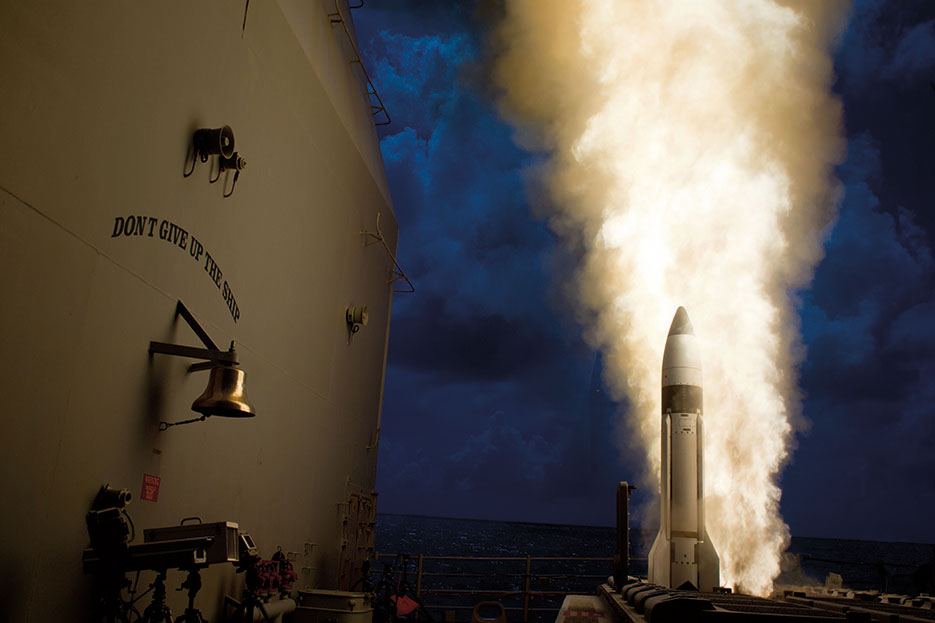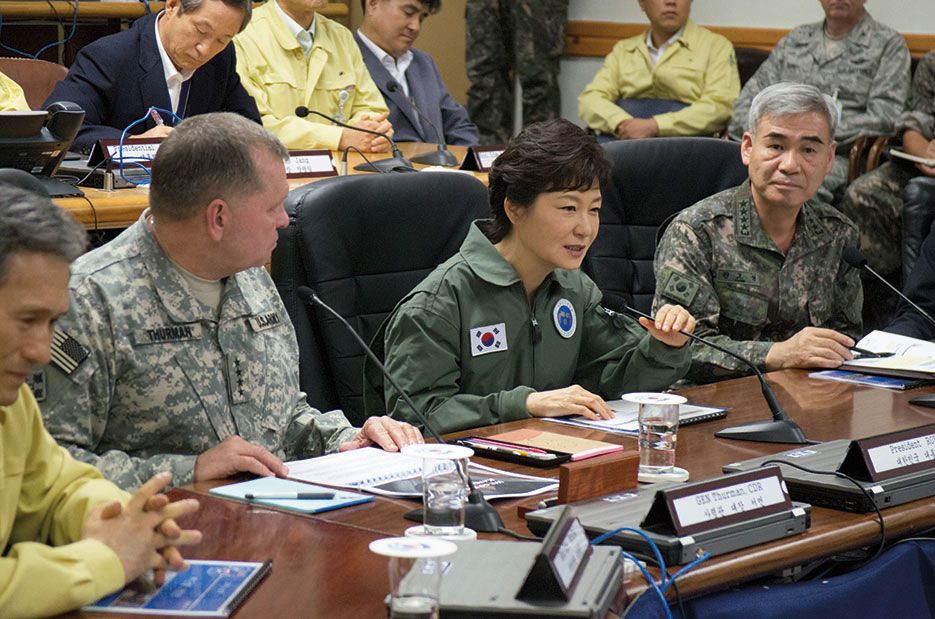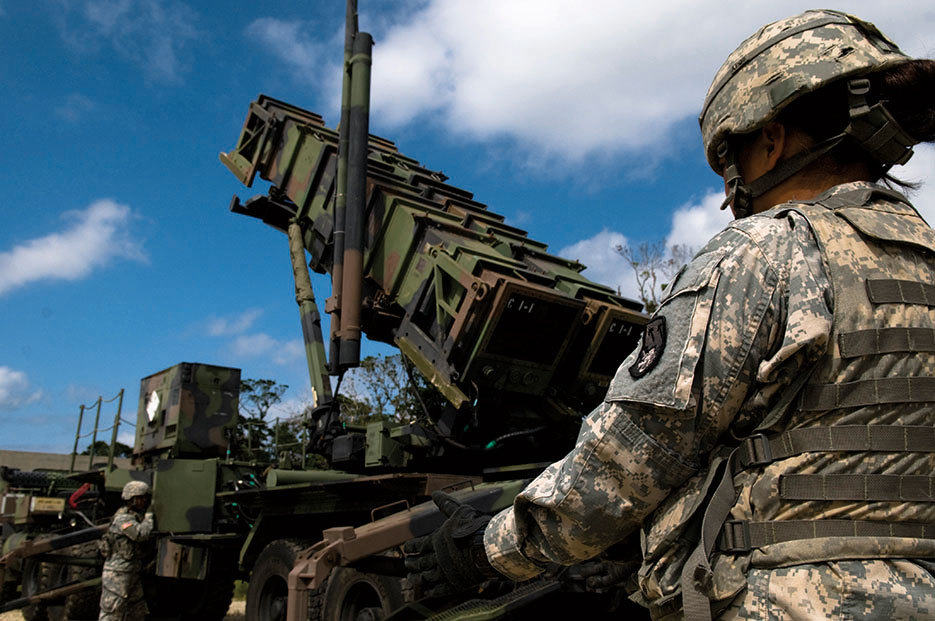Журнальный клуб Интелрос » Joint Force Quarterly » №79, 2015
Consider this possible scenario: A rogue nation threatens to fire ballistic missiles at the United States and its regional allies. In response, a forward-deployed U.S. Army radar transitions to high alert and continually scans the stratosphere, intending to detect and track the adversary’s ballistic missiles. U.S. Navy and partner nation Aegis ships armed with missile interceptors depart their home ports and steam toward prearranged operating areas. Meanwhile on land, missile defense convoys disperse near air and sea bases, activate their radars, and raise their launchers skyward. At multiple operations centers, Airmen plan attack operations against the enemy’s command and control and missile defense units. These joint missile defense movements require a sophisticated response, but what should the mechanism be to socialize, synchronize, and recommend these actions within a geographic combatant command? The answer: that mechanism would include inputs from the land, maritime, and air commanders (along with supporting agencies), yet present a holistic, inclusive, and effective missile defense response from the joint force commander.
Planning and executing a layered missile defense using the assets mentioned in the scenario requires coordination and integration among the land, maritime, and air components as well as subunified and regional missile defense partners. Not surprisingly, these resources for integrated air and missile defense will continue to be limited, as recognized by the Chairman of the Joint Chiefs of Staff in his Joint Integrated Air and Missile Defense: Vision 2020.1 Missile defense systems are complex, expensive, and limited in number, and the lack of affordable interceptors gives potential adversaries a cost advantage as it is cheaper and easier to launch ballistic missiles than to successfully intercept them. Navy Aegis ships, the Army Terminal High Altitude Area Defense (THAAD) system, and Patriot PAC-3 systems have proven and impressive intercept records.2 Yet these systems are finite in number, cost millions of dollars, and are in high demand across the combatant command’s (CCMD’s) area of responsibility (AOR). In short, integrated air and missile defense (IAMD) is an inherently joint and increasingly multinational and cross-CCMD mission area. How the geographic combatant commander or joint force commander (JFC) orchestrates these multi-Service and international missile defense operations requires a joint mechanism that is responsive and linked to the CCMD’s battle rhythm.
One solution is to operationalize the CCMD staff through the Board, Bureau, Center, Cells Working Group (B2C2WG) process with a dedicated and collaborative air and missile defense board—akin to the well-known and practiced joint targeting coordination board or the joint collection management board. A missile defense coordination forum does not exist in joint doctrine, yet a joint theater air and missile defense (JTAMD) board, fed by a supporting JTAMD working group, could provide the much needed joint IAMD planning and coordination support capability to the theater area air defense commander (AADC) and the joint force commander.

Guided-missile cruiser USS Lake Erie (CG 70) launches SM-3 Block 1B interceptor during Missile Defense Agency test and successfully intercepted complex short-range ballistic missile target off coast of Kauai, Hawaii (DOD/U.S. Navy)
B2C2WG Defined
The hierarchal Napoleonic system of “J-codes” has of course been used by military organizations for centuries and continues to align commanders and their staffs. But CCMDs and staffs have searched for responsive processes to function more effectively in a diverse, complex, and ever-changing geopolitical environment.3 The B2C2WG template offers a possible solution and has been embraced by U.S. Pacific Command (USPACOM) during its transition to an operationalized headquarters. In the past, CCMD headquarters relied on subordinate task forces as the operational sinew for the theater; now, however, the USPACOM directorates fulfill the operational as well as traditional strategic responsibilities. So instead of completely eliminating the 200-year-old system, USPACOM maintains the J-code system as a recognizable CCMD staff structure, but distinguishes the need to coordinate laterally through the vertically aligned staffs. Therefore, the B2C2WG process has been adopted as the mechanism to interconnect combatant command J-coded directorates and assimilate planners, operators, intelligence agencies, and stakeholders while simultaneously connecting with the functional component commands. The B2C2WG process has enabled traditional organizations to more effectively integrate and synchronize the battle rhythm process, in both peacetime and crisis. In November 2013, Operation Damayan (the coordinated theater-wide response to a massive typhoon that struck the Philippines) validated this methodology. It illustrated the ability of the USPACOM staffs, subordinate task forces, partner nations, and interagency teams to rapidly employ a productive and sustainable battle rhythm during a crisis.
The same responsiveness demonstrated in the Damayan relief efforts needs to be applied to missile defense and should be included in the USPACOM B2C2WG process. North Korea’s missile arsenal remains a worrisome threat to U.S. and allied security and in fact continues to grow, as evidenced by the 2014 firing of ballistic missiles into the sea toward Japan. Successive USPACOM commanders continue to describe North Korea’s nuclear and missile capabilities and its proliferation of weapons of mass destruction and associated technologies as the major challenge to stability in the region.4 The enormity of the region (the USPACOM AOR covers half the Earth, contains over three billion people, and includes the world’s three largest economies and one-third of all U.S. trade) also epitomizes missile defense challenges. The obligation to multiple subunified commands and treaty obligations further strain the demand for limited missile defense resources. Of the seven total security treaties signed by the United States, five reside in the USPACOM AOR with Australia, Japan, the Philippines, South Korea, and Thailand. Each represents differing missile defense capabilities, and further exemplifies the need for a doctrinally recognized, theater-wide JTAMD board.

General James D. Thurman, United Nations Command, Combined Forces Command and United States Forces Korea commander, and General Kwon Oh Sung, Combined Forces Command deputy commander, brief Republic of Korea President Park Geun-hye on status of Ulchi Freedom Guardian exercise, August 22, 2013 (U.S. Army/Brian Gibbons)
Northeast Asia, and in particular the potential battlespace between the Korean Peninsula and the Japanese archipelago, illustrates the complexity of missile defense in the USPACOM AOR and the need for the JTAMD board. For example, the Republic of Korea’s navy employs KDX-III-class Aegis destroyers and Patriot PAC-2 missile batteries, while nearby Japan uses Kongo-class Aegis ships and Patriot PAC-2/3 interceptors. In and around both countries, U.S. forces (possessing similar Patriot and Aegis assets) must be able to complement the regional defense architecture while protecting the homeland from intermediate and intercontinental ballistic missiles targeting Guam and the United States. Sensors such as AN/TPY-2 and SPY-1 radars and Japanese and Korean sensors can cue other systems, greatly reducing the time required to compute firing solutions. Concepts such as “launch on remote” and “engage on remote” via datalinks are significantly extending the range of missile intercepts—meaning a successful ballistic missile defense (BMD) kill chain (sensors, shooters, command and control) must overcome regional and political boundaries. For instance, a U.S. Aegis ship positioned between South Korea and Japan could impact missile defense for either country. With an overlapping defense framework, ships and ground-based units are assigned primary defense responsibilities such as those found in the defended asset list (DAL). But if coordinated and planned, these systems can also assist one another as a “backup” shooter and, in some cases, serve as the tertiary defense. It is imperative that these efforts are synchronized because of the finite numbers of Patriot, THAAD, and SM-3 interceptors and the multirole mission requirement to provide an air defense capability within the AOR.5 To effectively manage these limited assets, the JFC and the AADC staffs must have an adaptable coordination mechanism to rapidly plan across vertically stovepiped organizational hierarchies. The theater AADC certainly retains the prerogative to engage the JFC in all air and missile defense issues at any time. However, due to the complex relationships among partner nations, other U.S. agencies, and CCMDs, the JTAMD board’s ability to plug into the CCMD commander’s battle rhythm could hasten theater and cross-AOR missile defense coordination.
Currently in U.S. Army doctrine, a theater air and missile defense (TAMD) coordination board (formerly known as a reprioritization board) led by the deputy AADC exists primarily to recommend changes to the DAL, a JFC-approved list of protected assets connected to a specific operations plan.6 The joint TAMD board would build upon this framework, open the aperture to other topics besides DAL prioritization, and include other members. Coalition participation early in the C2B2WG process could facilitate faster allied approval and collaboration on proposed operations. In addition to multinational participation, other JTAMD board members/observers should also include subunified commands such as U.S. Forces Korea (USFK) and U.S. Forces Japan (USFJ). An IAMD functional representative from the CCMD or JTF headquarters and, in some instances, other missile defense organizations would also attend. The Missile Defense Agency (MDA), the U.S. Strategic Command (USSTRATCOM) Joint Force Functional Component Command for Integrated Missile Defense, and the Joint Integrated Air and Missile Defense Organization already provide liaison officers to USPACOM, and their participation would allow the vital contributions of those supporting organizations. As a case in point, the MDA Sea-Based X-Band radar, normally used for testing, could augment an operational layered missile defense, but would require inter-CCMD coordination. Other JTAMD board observers would include the global force management and the J4 munitions divisions in order to facilitate requests for forces and expedite replenishment of high-demand replacement missiles.
In an attempt to mimic and codify the success of the staff response during Operation Damayan and other B2C2WG achievements, USPACOM AADC and CCMD officers explored ways to improve missile defense integration with the goal of a collaborative problem-solving process. Subsequently, during Exercise Keen Edge 2014, the deputy AADC expanded the U.S. Army’s process to include joint participants such as USFJ, the Japanese Self-Defense Forces, and CCMD officers. Additionally, during Exercise Ulchi Freedom Guardian, USFK and the theater deputy AADC further refined the joint process with Republic of Korea forces. Both exercises demonstrated the success of an inclusive JTAMD board by improved allied involvement during planning, and significantly aligned the staffs in supporting the missile defense weight of effort. With further improvements to the JTAMD process, continuing development of IAMD officers, and additional changes to joint doctrine, missile defense could become even more effective.

U.S. Soldiers perform pre-launch checks on Patriot missile launcher as part of field training exercise on Kadena Air Base, Japan (U.S. Air Force/Maeson Elleman)
Recommendations
First, the JTAMD planning process should be adopted as a joint IAMD planning capability and must be exercised regularly and continually refined. Combatant commands need to adopt a coordinated and integrated approach to missile defense training scenarios that include all elements, from tactical units (sensors and shooters) all the way to national command authorities. Air and missile defense must be considered early in exercise development, and all training, testing, and evaluation events should dovetail into an overall tactical-operational-strategic “pathway to victory” road map. The deputy AADC-led JTAMD board should offer a forum to formulate and provide timely adjudicated solutions not only for DAL priority, but also for interceptor resupply, requests for additional forces, cross-CCMD coordination, and changes to regional defense and readiness postures (alert states). Complex missile defense systems are increasingly no longer just regional, but impact multiple commands, and thus maintenance requirements for long-range radars such as the AN/TPY-2 need an operationally focused venue. Additionally, the USPACOM AOR, which includes the MDA Reagan Test Site in Kwajalen Atoll and the Pacific Missile Range Facility in Hawaii, conducts one of the most complicated and intricate missile defense tests in the world. A JTAMD process would serve as a conduit to strengthen warfighter and MDA efforts such as combining real-world missile tests with operator training at every opportunity. Previous MDA tests have included realistic scenarios with multiple engagements of Patriot, Aegis BMD SM-3, and THAAD missiles against live targets, and recently demonstrated the successful first firing of the Aegis Ashore weapons system. Therefore, to better leverage these singular live events, the JTAMD board (supported by a JTAMD working group chaired by a captain or colonel) should be instituted and practiced to inculcate the collaborative process and render it routine.
Second, as Joint Publication 3-01, Countering Air and Missile Threats, undergoes revision, more of its content should be devoted to the development of joint air and missile defense officers and intra- and inter-CCMD coordination. Although USPACOM currently holds the distinction of being the only geographic combatant command to conduct both regional and homeland missile defense, other regional AADCs and JFCs will be required to routinely coordinate across combatant command boundaries as the air and missile threats to the Nation and its regional partners continue to mature and proliferate.
Last, in August 2012, the Deputy Secretary of Defense designated USSTRATCOM as the joint lead for integrating and synchronizing joint BMD training in coordination with the CCMDs and the military departments.7 However, there is currently no joint organization in the Defense Department tasked with the responsibility of training and developing joint IAMD planners. More must be done to cultivate and track qualified and experienced joint IAMD officers, as their experience is crucial to joint layered missile defenses. CCMD and Service personnel managers currently are unable to adequately identify experienced joint IAMD planners to fill billets. A better way to manage human capital would be to establish a joint air and missile defense skill identifier, that is, a military occupational specialty or Air Force specialty code. Whether an Airman, surface warfare officer, or air defender, these officers epitomize jointness, as they understand not only their Service-specific weapons systems, but also component interdependencies and enablers. Initiatives such as regional IAMD centers in U.S. Central Command, U.S. European Command, and the emerging USPACOM efforts are to be commended for filling the joint IAMD training void. But a more formalized joint training pipeline is necessary to train and track qualified joint IAMD-qualified personnel.
The JTAMD board would not be the panacea to complex missile defense planning and execution, but it would allow for deliberate and crisis-action planning processes to shape missile defense strategy in all phases of conflict. Much like the better known joint targeting coordination board and joint collection management board, the JTAMD board needs to mirror its importance in joint doctrine. The board has the potential to act as a leveler to bring the many facets of missile defense across the Defense Department and partner-nation staffs together. During peacetime operations, the JTAMD board should meet regularly; however, during exercise or contingency operations such as a North Korean provocation cycle, it could convene daily. In sum, the JTAMD board could serve as a much needed “nonmaterial” enabler for expensive air and missile defense systems to make them more complementary and effective. JFQ
Notes